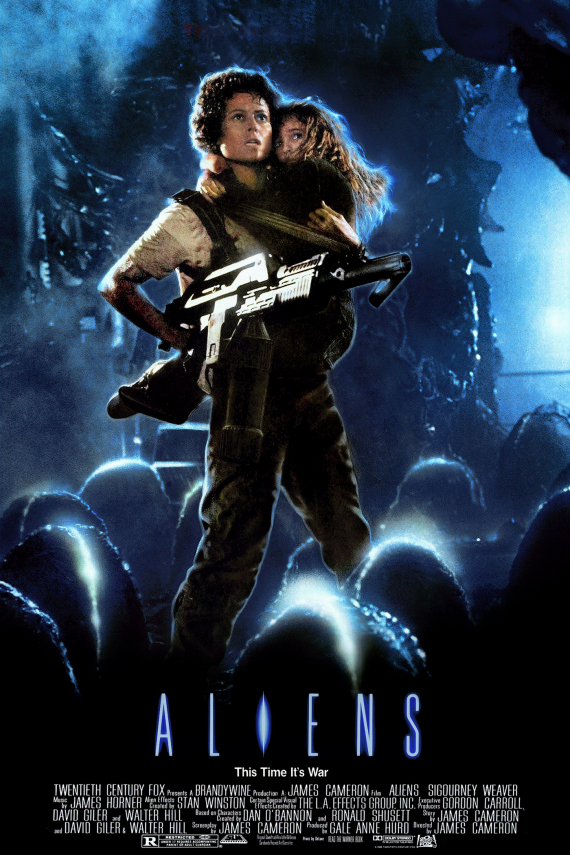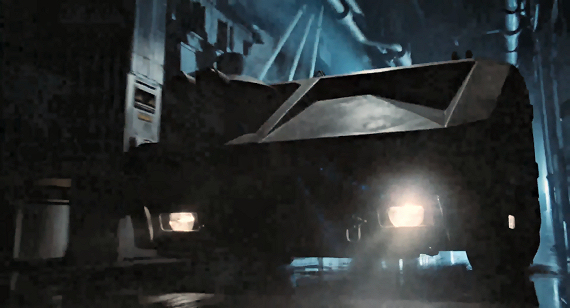
For my next “near-perfect” movie, I nominate Aliens. I’m going to write this as if you’re totally unfamiliar with the Alien franchise, even though you are probably as familiar as I. With any luck, you’ll find some information in this review you didn’t know, or a point of view you either haven’t thought of, or want to agree with, expand on, or dispute! I realize this is pretty long, so I’m going to break it in the middle and ask you a question. Let’s start:
In 1979, Ridley Scott’s Alien came to theatres and, although it was in some ways a space rewrite of Agatha Christie’s Ten Little Indians, it became an instant genre classic. (There was much more to it than just counting down the casualties, of course.) It made instant genre stars of Sigourney Weaver, Ian Holm, John Hurt, Tom Skerrit… yes, also Yaphet Kotto, Veronica Cartwright, Harry Dean Stanton—most of whom were already known to a greater or lesser degree in film, but had now quickly become genre icons. As was H.R. Giger for his set designs, Bolaji Badejo in the “alien suit”, and Jerry Goldsmith for his score, practically ensuring that a sequel would be made.
It was seven years later that a sequel was made, not by Ridley Scott, but by James Cameron, thanks to the latter’s success with The Terminator. I won’t go into the background of this film; you can read it all for yourself on IMDB.com. There’s some fascinating trivia there. Where the first movie had seven characters (in most non-English theatres, the movie’s title was The Eighth Passenger), this one had a whole bunch of ‘em. Besides Weaver as Ripley, reprising her role from the first film, we had “Colonial Marines”; a new android named Bishop, played by Lance Henriksen; a Company (Weyland-Yutani) representative named Burke (Paul Reiser from Mad About You); and the lone survivor from the colony on LV-426, a little girl called “Newt” (Carrie Henn). Sorry to be the bearer of bad news, but most of the marines didn’t stay around for most of the film; the ones we notice most are Sergeant Apone (Al Matthews); Lt. Gorman (William Hope); Private Hudson (Bill Paxton); Private Hicks (Michael Biehn); Private Vasquez (Jenette Goldstein), and a few who have one or two lines. Like Drake (Mark Rolston), Frost (Rico Ross), Ferro (Colette Hiller), and Spunkmeyer (Daniel Kash).
Although in Alien, Ripley was just one of the crew—and the sole survivor of the commercial “tug” Nostromo (except for Jones, the cat), she is the main character of this, the first sequel. (Since Cameron has said that this franchise, as well as Predator and Terminator, take place in the same shared universe, that means the film could expand even farther in the future.) We learn a lot about her, including the fact that she was a mother, which gives even more resonance later in the film.
Simply put, her little lifeboat, the Narcissus, drifting in space after the events of the first movie (Ripley is in suspended animation), drifts out of the commercial space lanes and gets lost for 72 years. The people of another ship, hoping for salvage, are dismayed when the Narcissus has a live person and a cat in hypersleep (or stasis, or whatever they called it). Brought back to a station orbiting Earth, Ripley learns that her daughter has died while she was drifting in space. The Company (now known to be Weyland-Yutani) attempts to find out the events involving Ripley, the Nostromo, and the asteroid/planetoid LV-426; she is told that the Nostromo and the mining facility it was towing were worth billions, and she’s responsible for blowing it all up. “They can bill me,” she snaps. The board ends up suspending her pilot’s license, effectively grounding her.

She is visited by Carter Burke (Reiser), accompanied by Marine Lieutenant Gorman (Hope), who tells her that in the interim between blowing up the Nostromo and her being discovered in space, a colony has been established on LV-426, and terraforming has begun, with a giant air plant which will make the planetoid habitable over a period of years. However, contact has been lost with the colonists. The Company will reinstate her if she accompanies Burke, Gorman, and a company of Colonial Marines (in case her warnings about the deadly aliens are true) to find out what happened on LV-426.
Burke is as slimy a character as you’re likely to meet, and we, the audience, take an almost instant dislike to him (as was intended). Gorman is a near-non-entity; a recent graduate, it seems, of whatever schools put out Colonial Marine officers. After a few nightmares involving a scene we all remember from the first movie, she reluctantly agrees to return to LV-426. “You’re going there to destroy them,” she asks Burke, “not to study, not to bring back?” Burke agrees that’s the purpose, and we all know better… but she believes him because she wants to believe.
On board the dropship Sulaco, on the way to LV-426, Ripley and Burke meet Sgt. Apone (Matthews), who is the first out of stasis, then the rest of the Marines. She (and we) meet Vasquez (Goldstein), a real hard-ass; Drake (Rolston), her partner on the “smart guns”; Hudson (Paxton), the squad’s jokester, and Hicks (Biehn). Over breakfast she gets acquainted with Bishop, and finds out he’s an android (“I prefer the term ‘artificial person’,” he says). Thanks to Ash on the Nostromo, she distrusts them, and tells Bishop to stay away from her. Channeling Isaac Asimov’s “Three Laws,” he tells her it’s impossible for him to harm a person, or by omission… well, you know the rest.
The interplay on the Sulaco tells us a lot about the Marines, and we learn Ripley can handle a mechanical loader, which is a powered exoskeleton. (There appear to be Robert A. Heinlein references in all this; the “dropship” and the powered loader seem to echo Starship Troopers and the Mobile Infantry’s power armour; and Hudson asks Apone whether this is a “stand-up fight or another ‘bug hunt”—again, seeming to echo Starship Troopers’ arachnoids.) They all take a lander down, all but Ferro (Hiller) and Spunkmeyer (Kash) in an APC, or Armoured Personnel Carrier (a vicious-looking vehicle). The latter two are pilot (Ferro) and copilot (Spunkmeyer) of the lander. Gorman tells Ferro to take a turn around the atmosphere plant and colony, then they land. The vehicle disembarks, and Ferro is told to back the lander off until called for; she lands it away from the facility to wait.

At the entrance to the facility, Hudson hacks the electronic doorlock, and they enter the facility—with Drake and Vasquez leading the way with their smart (smrt!) guns… finding it deserted. There are holes in floor and ceiling/roof, some of them obviously (if you’ve seen the first movie) from xenomorph (which is what we’re calling the non-face-hugger aliens now) blood, which we know (but the Marines don’t) is an extremely corrosive substance, able to eat through several decks. They find a survivor hiding in a vent; it’s a little girl (Henn) named Rebecca (though she prefers to be called Newt). She tells them the colonists are all dead, including her family and little brother. Maternal instincts aroused (remember, she’s just found out she lost her daughter), Ripley takes charge of Newt, assuring her that the Marines are heavily armed and can protect her. “It won’t matter,” Newt tells her, “You’re all gonna die. They mostly come out at night. Mostly.”
The group enters the medical facility, and finds some glass or lucite cylinders full of a liquid that is obviously keeping two facehuggers alive, along with some dead ones. Bishop dissects one of the dead ones, marveling over it; he finds it fascinating. The colonists are all wearing trackers, and a scan finds all the colonists apparently congregating in one of the cooling towers of the atmosphere plant’s reactor. Gorman gets them all back in the APC, and they head off to find the colonists.

What they find inside the cooling plant is xenomorph-secreted bio-resin, built up into forms we saw back inside the original crashed space ship that had the eggs that contained face-huggers. Apone leads a party down into the tower to find the colonists; Gorman, Ripley, Newt and Burke stay in the APC; Bishop is still back at the med lab. Ripley notes that they shouldn’t use live ammo, because they could puncture the cooling tower, leading to a runaway reaction and meltdown; Apone collects all the live ammo and tells them to use flamethrowers. (“What are we supposed to use,” Hudson whines, “harsh language?”) Vasquez secretes a couple of clips of live ammo and gives one to Drake.
And here’s where the real action starts, so here’s where I’m going to break this column into two parts. If I kept on the same way, I’d be over 3000 words, and I’m sure you don’t want to read that much at one go. Please write to me and tell me whether you’re comfortable with this. Maybe I should go into less detail (after all, this movie is over 30 years old), and do the whole movie at one go. Maybe I should give even more attention to detail and tell a lot of stuff that I’ve left out of this.
You decide. If I don’t hear back from a lot of you, I’ll assume that this is a good way to do these “near-perfect” films. Fair enough?
Comments? If you have anything to say about my column, go ahead—say it! Say it here, or on Facebook, or even email! (stevefah at hotmail dot com.) I’d like to hear what you think—but try to keep it polite, okay?) My opinion is, as always, my own, and doesn’t necessarily reflect the views of Amazing Stories or its owner, editor, publisher or other columnists. See you next time!










